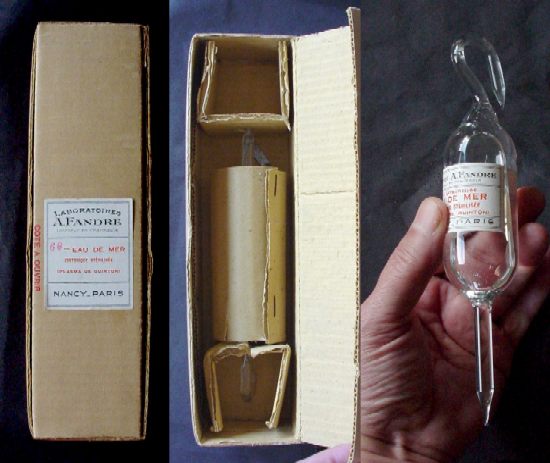 |
| um 1910 |
Glass infusion bottles were introduced at the beginning of the 1950s. Long before, however, there were glass ampoules that were used as an infusion. Such an ampoule is discussed here.
Presented is an original bottle of the company "Laboratoires A. FANDRE" from Nancy:
"Eau de Mer isotonique stérilisée (Plasma de Quinton)".
Outer mass of the packaging 25 cm, length of the ampoule 18.5 cm. Note the "gooseneck" of the vessel on which it was hung.
René QUINTON (1867-1925) had already demonstrated in 1896 the similarity of the most debased plasma with the seawater of the sea, and had managed to keep alive a living human cell (a "white blood cell") in seawater. In 1904 he published "L'Eau de mer, milieu organique, constance du milieu marin originel, comme milieu vital des cellules, a travers la série animale" in which he pointed out that our "inner" milieu is nothing but a subsequent state of seawater, where all life once took its source. Hence his suggestion to use sea water for rehydration ... Thousands of people were saved by using this solution. However, the "Plasma de Quinton" disappeared after the Second World War from pharmacies and was replaced by synthetic products.
One reason for the high mortality in previous operation was the shock, which was defined by LeDRAN in 1773, but was not accessible to any treatment, especially as first attempts at blood transmission failed (POTTER 1650, LOEWER 1666). Only in 1881 did Albert-Sigmund LANDERER (1854-1904) succeed in Leipzig in the stabilization of circulation by saline infusions. To bind this solution longer in the vascular system was added during the First World War gum arabic, a process that was quickly abandoned because of occurring chills and fever ...
In 1907, the "Plasma de QUINTON" was first commercialized. The fact that it is nowadays prescribed against all possible causes is rooted in the anthroposophical roots of Quinton's views - plasma against cancer, plasma against childhood diarrhea, plasma to cleanse the colon ...
QUINTON's plasma was much more than a modern "isotonic saline solution" - it was a "living" water. Quinton's original water was pumped out of the sea in very specific places, from the so-called "vortex", i. Vertebrae, where special biological and electrical conditions prevail.
www.graal-france.net/index.php?printpreview=true&page=2331
"René Quinton détermina certaines zones spéciales pour prélever une eau pure et" vivante ", destinée à préparer son" Plasma de Quinton. "Ces zones sont appelées techniquement" Vortex "et présentent des courants tourbillonnaires, une température constant, une composition minérale peu variable , ce qui permet la reproduction du phyto et du zooplancton, Recueillie par 30 mètres de profondeur et à 10 mètres du fond de l'océan, analysis et filtrée sur place, l'eau est transportée aux laboratoires Quinton sous température contrôlée et conservée à 4º / 6º C in chambre spéciale, au maximum pendant 45 jours.A laboratire, l'eau est à nouveau microfiltrée à froid and conditionnée dans des ampoules stériles de 10 ml; on obtient ainsi une eau de mer naturelle hypertonique (30 g / l) , 30 grams of sels totaux par litre, commercialized sous le nom de Quinton® Hypertonic Buvable, Pour ramener la concentration marine à l'isotonie sanguine de 9 g / l, l eau de mer est diluée au laboratoire avec de l'eau naturelle minérale non chauffée (Aqua Fontana) car Quinton avait mis en évidence que l'eau distillée (stérilisée par chauffage) faisait perdre beaucoup de ses propriétés à l'eau de mer. On obtient ainsi une eau dont la salinité est de 9 g / l de sels totaux; elle est commercialisée sous le nom de Quinton® Isotonic Buvable (appelé à l'origine "Plasma de Quinton") ".
The infusions were initially given intra-arterially. LANDERER could prove in the late 19th century that the same effect was achieved by intravenous administration. Nevertheless, for decades, they continued to apply the solutions subcutaneously or rectally ...
www.quinton.ch/prelevement.htm
|